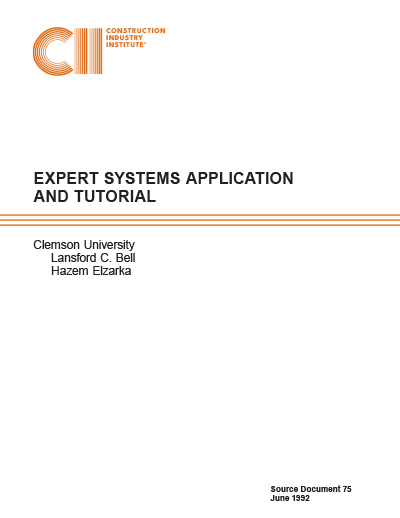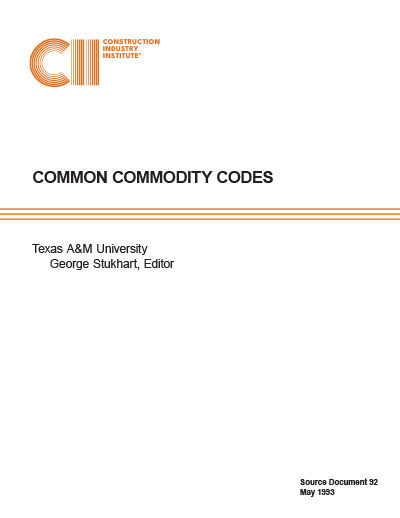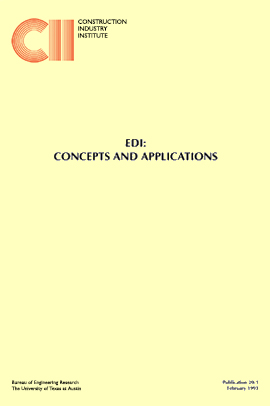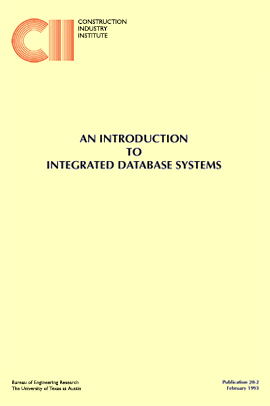
Expert Systems Application and Tutorial
An expert system can best be defined as a computer program that emulates the problem solving process used by human experts. Expert systems are also called knowledge based systems, or rule based systems. Some authors prefer the term “intelligent assistant.”
Expert systems are well suited to solving problems where judgment and experience play an important role. Admittedly, expert systems rarely perform better than experts. However, experts are not always available, nor do they always have the time to formally evaluate all available information or consult established references and specifications before reaching a conclusion or recommendation.
Although expert systems have not as yet become commonplace in the construction industry, proven applications are being used on a routine basis. CII member firms have developed a wide range of applications that apply to facility design, construction, and operations activities. Applications have been developed to assist with such diverse tasks as parametric design, design review, document drafting, flow balancing, claims resolution, crane rigging, pipe welding, and roof inspection. It should also be noted that the CII Modularization Task Force is in the process of developing a working expert system as a way of conveying modularization practices to the industry.
The general reluctance to adopt expert systems applications in the construction industry can be attributed to a number of factors. Certainly top management can not justify investing in system development projects when the resulting cost saving benefits can not be projected in advance. More important, there is a general lack of understanding of expert systems concepts within the industry.
Expert systems technology is not complex. An expert system, like a PC spreadsheet, is a tool that can be used to provide data processing efficiency for a particular class of problems.
The objective of a recently completed CII research project was to develop a product that would promote better understanding of expert systems technology and identify promising construction industry trends and applications. It was determined during the course of the research that a “hands-on” Tutorial, with examples chosen from the construction industry, would serve as the ideal vehicle for communicating expert systems fundamentals to CII member firm personnel. A hands-on Tutorial is therefore included as part of this Source Document report. The Tutorial, which can be used as either a stand alone teaching tool or seminar reference, will hopefully stimulate informed discussions among a wide range of project decision makers to promote the effective utilization of expert systems throughout the construction industry.
The research described herein was conducted with input from a wide range of sources. Clemson University researchers participated in a number of expert systems conferences and consulted with persons actively involved in the expert systems development and implementation process. Several in-house seminars were conducted using the Tutorial instructional materials to evaluate the effectiveness of the Tutorial exercises.
This report is organized such that the reader is introduced to the role of expert systems in facility design, construction and operation in Chapter 2. Hypothetical expert decision making scenarios are presented in Chapter 2 and then incorporated into the Tutorial sample exercises in Chapter 3. The Tutorial exercises in Chapter 3 focus on illustrating the very basic principles of expert systems that include induction tables, forward and backward chaining, confidence factors, and links to other software packages.
No previous knowledge of computer programming or expert systems is required to perform the sample exercises. However, because expert systems frequently utilize data from spreadsheets, databases, and text files, some knowledge of popular PC software packages will enhance the user’s learning experience. A diskette containing the Tutorial exercises and related data files has been distributed with the Tutorial.
Basic guidelines for developing an expert systems project and useful reference sources are presented in Chapter 4. Expert systems applications and trends in facility engineering and construction are discussed in Chapter 5. The focus of the discussion is on applications that have been applied to actual project situations and the factors that have contributed to implementation success. Chapter 6 contains recommendations for promoting the technology throughout the industry. A number of VP Expert demonstration programs that contain expertise secured from established technical references and interviews with experts are presented in the report appendices.
The report was developed to promote a better understanding of expert systems technology and identify promising construction industry trends and applications. An expert system can best be defined as a computer program that emulates the problem solving process used by human experts. Expert systems are also called knowledge-based systems, or rule-based systems. Some authors prefer the term “intelligent assistant.”
It was determined during the course of the research that a “hands on” tutorial, with examples chosen from the construction industry, would serve as the ideal vehicle for communicating expert systems fundamentals to CII member firm personnel. One reason for the relative scarcity of construction applications is perhaps a lack of technology familiarity on the part of construction management personnel. It is anticipated that the tutorial portion of this report will serve as an effective mechanism for conveying expert systems fundamentals to both domain experts and persons responsible for expert systems development efforts. (SD-75, p. 87)
SD-75, Expert Systems Application & Tutorial
A hands-on tutorial which can be used as either a stand-alone teaching tool or seminar reference, and is intended to stimulate informed discussions among a wide range of project decision makers to promote the effective utilization of expert systems throughout the construction industry.
EDI Implementation – Provides a logical overview and implementation flowchart showing EDI implementation strategy.
IDB Implementation – Provides a logical overview and implementation flowchart showing IDB implementation strategy.


